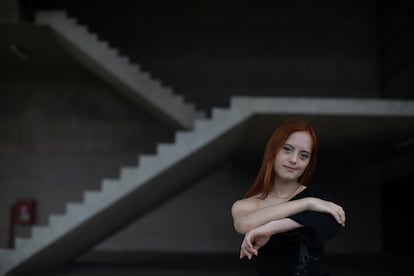Maju de Araújo, the Brazilian model with Down syndrome making a stand on the catwalk
The Rio-born teenager is an ambassador for L’Oréal, has modeled at Milan fashion week and is helping to change the way the industry addresses diversity

Maria Julia de Araújo, 19, is a model who is less than five feet tall, well below the usual height required for the catwalks. She doesn’t have a slender body like the top models who grace magazine covers worldwide. She has long, straight hair, almond-shaped brown eyes and an easy smile. Even so, Maju, as she is known, has become a model of international renown. She has modeled at three major fashion weeks, including Milan, and is the new ambassador for L’Oréal Paris. Maju, who has Down syndrome, has a very busy work schedule but says that so many commitments only tire her out “a little.” She is meeting with EL PAÍS alongside her mother, Adriana de Araújo, and her sister Larissa, in the Cidade das Artes cultural center in Rio de Janeiro, where she was born and now lives with her parents and two sisters. When the photographer for the report points his lens, she swiftly opens her shoulders, arches her back, half-opens her mouth and poses for the camera. Three years in the business has accustomed her to modeling. But the world has yet to become accustomed to her.
As a child, Maju loved to play at being a model. She would wrap napkins around her waist, which were like the sheer dresses of the catwalks, and imagine she was being photographed. “I thought the world of fashion would be inaccessible for her,” says her mother, Adriana. In fact, Maju’s path has never been easy. She is the youngest of three siblings, her father is a systems analyst and her mother a chef. Adriana explains that she spent Maju’s entire childhood hearing the word “no,” when trying to attend to her daughter’s wishes. “On several occasions, we approached schools and they would say they had no places left,” she says. As a result, when Maju said she wanted to be a model, her mother didn’t take it seriously.
Things started to change when Maju went into a coma due to meningitis. When she woke up, after the doctors had given up hope, she told her mother that she intended to be a “famous model.” It was the catalyst that made Adriana start to believe in her daughter’s dream as well. “At that time, we had serious financial problems,” says Adriana. “The only cash I was able to spare was 200 reales [$35, €30], which was what the registration for the school of modeling cost. I thought, ‘My daughter deserves this’.” Adriana had a job catering events. “I used to take my three daughters to work with me. Maju helped to put the dishes together.”
In spite of the obstacles, the family decided to invest what little they had in Maju’s training. However, they didn’t know the registration fee was just the tip of the iceberg. Again, they found doors did not open easily. “I threatened to sue the modeling school, who didn’t want to accept my daughter. That’s where I took my first stand,” says Adriana, who today is a consultant and a kind of spokesperson for her daughter, who has difficulty speaking.
Maju communicates perfectly well through expressions and sign language, which she used when taking part in a six-month series on Instagram. Her sister Larissa, 25, and her mother help her to tell her more than 387,000 followers about the ins and outs, and the results, of their work. “We also monitor the comments,” says Larissa. “There are a lot of haters. Many people say, for example, that she is white and privileged.”
The family breadwinner
Maju completed the modeling course in Rio in 2019. However, professional opportunities were slow to arrive. She spent a lot of time working in exchange for products, instead of money, which is common practice among models who are starting out. Only when she signed a contract with the agency Mind, which works with image and not just in the modeling industry, did people start to talk about her cachet and then the work started to become more professional.
Today, Maju practically maintains her family. “Maju has given us financial stability through her work,” says her mother. Thanks to her job, Maju has traveled around Europe, in Italy, Portugal and France. “Paris was my favorite, because it is chic,” she says with a smile. Which country would she like to visit? “China,” she replies. And she has many more dreams she wants to achieve. “I want to be on a billboard,” says Maju, a lover of sushi and ice cream, whose greatest professional pleasure is “being photographed and being on the catwalk.”
Her mother stresses that there have been no shortcuts in her daughter’s trajectory. “If a person who is considered normal according to society’s standards has to walk 6,000 kilometers to get to where they want to be, Maju would have to walk four times further to demonstrate her ability.” The big modeling agencies are reluctant to hire her daughter. “They say that Maju doesn’t have the profile clients are looking for,” says Adriana. “The reality is that people with disabilities have always lived in social isolation.”
Selective diversity
This rejection by agencies exposes how the market is ignoring a huge audience. According to the last census by the Brazilian Institute of Geography and Statistics, carried out in 2010, 24% of Brazil’s population has at least one of the disabilities measured by the survey: visual, auditory, motor and mental or intellectual. In total, 46 million Brazilians stated they suffer from some form of disability. “I tend to say that people with disabilities are the largest minority in the world,” says Ivan Baron, 23, who describes himself as an inclusion influencer and shares information on the issue with his over 160,000 Instagram followers.
Ivan, who has cerebral palsy, acknowledges that many companies are willing to change. “The brands have started to seek me out and have realized that they can attract customers through my discourse,” he says. “It was a big achievement when I became an official ambassador for Spotify, one of the biggest music platforms in the world.” However, Ivan stresses there is a big difference between diversity and selective diversity. “There are companies that think just by flying an LGBTQ+ flag they are being inclusive.”
Ivan uses the term “Def Money” when talking about brands that sell themselves as diverse, but do not embrace diversity as a policy. “In the same way as pink money, in the case of the LGBTQ+ community, and black money, with the Black Lives Matter movement, there is Def Money, which comes from the word deficient. These are brands that take advantage of our image and our bodies for a few seconds to paint themselves as inclusive,” he explains. “For example, they use someone in a wheelchair to advertise a store that doesn’t have accessibility.”
For this reason, Ivan uses his Instagram account to bring these concerns to public attention and to feel represented. “I grew up without any kind of representation, I didn’t see myself represented as a young person with a disability. And when you don’t feel represented, you think that you don’t exist.” Adriana says that Maju has the same purpose: “Her true mission is to expand the visibility of these people, because they are real people.”
Tu suscripción se está usando en otro dispositivo
¿Quieres añadir otro usuario a tu suscripción?
Si continúas leyendo en este dispositivo, no se podrá leer en el otro.
FlechaTu suscripción se está usando en otro dispositivo y solo puedes acceder a EL PAÍS desde un dispositivo a la vez.
Si quieres compartir tu cuenta, cambia tu suscripción a la modalidad Premium, así podrás añadir otro usuario. Cada uno accederá con su propia cuenta de email, lo que os permitirá personalizar vuestra experiencia en EL PAÍS.
¿Tienes una suscripción de empresa? Accede aquí para contratar más cuentas.
En el caso de no saber quién está usando tu cuenta, te recomendamos cambiar tu contraseña aquí.
Si decides continuar compartiendo tu cuenta, este mensaje se mostrará en tu dispositivo y en el de la otra persona que está usando tu cuenta de forma indefinida, afectando a tu experiencia de lectura. Puedes consultar aquí los términos y condiciones de la suscripción digital.
More information
Archived In
Últimas noticias
Most viewed
- Reinhard Genzel, Nobel laureate in physics: ‘One-minute videos will never give you the truth’
- Oona Chaplin: ‘I told James Cameron that I was living in a treehouse and starting a permaculture project with a friend’
- Pablo Escobar’s hippos: A serious environmental problem, 40 years on
- Why we lost the habit of sleeping in two segments and how that changed our sense of time
- Chevy Chase, the beloved comedian who was a monster off camera: ‘Not everyone hated him, just the people who’ve worked with him’









































